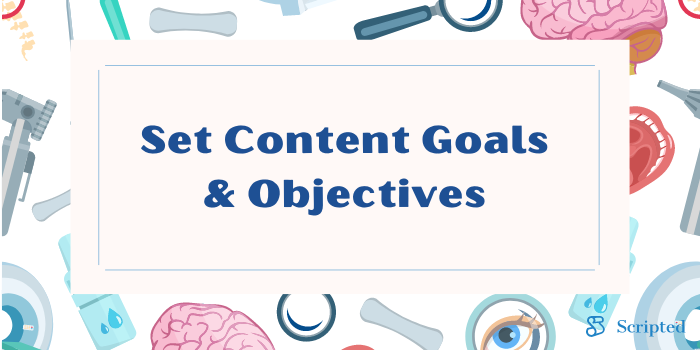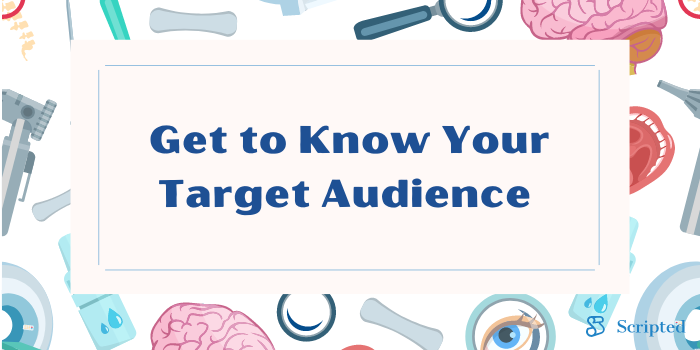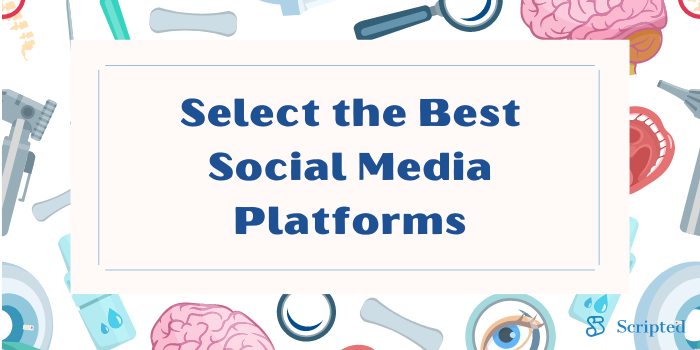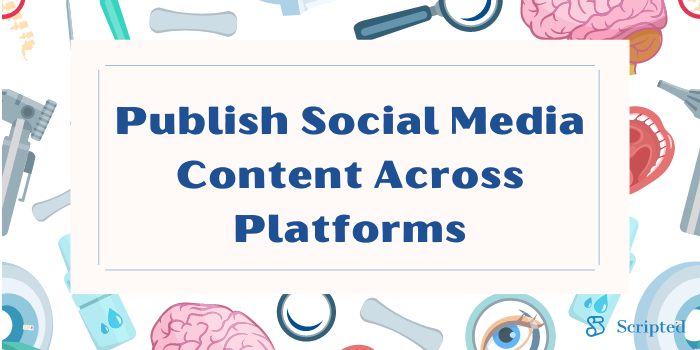- Blog Home
- Social Media Marketing
- Jubilee Heutmaker
- Social Media Content Strategy For Your Healthcare Site
Social Media Content Strategy for Your Healthcare Site
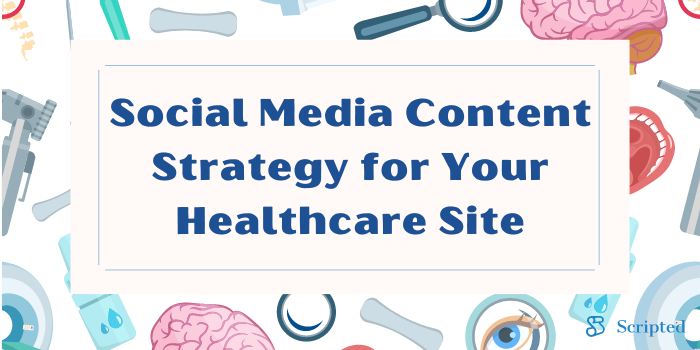
If you’re in the healthcare industry, it can be a challenge to figure out how to market your product or services using social media. A successful social media content strategy requires a range of steps from setting goals and choosing platforms to create a calendar and measuring your results.
The key: know your target audience inside and out.
Why? Because, now more than ever, more than 50 percent of global consumers have increased their reliance on digital and about 25 percent have increasing concerns about their health according to a PwC survey. If you’re not taking advantage of social media and SEO posts to drive traffic to your website, consumers won’t be able to find you. Equipped with the right social media content strategy, you’re sure to achieve whatever goals you set for your healthcare site.
Here are the steps to get you started!
Step 1: Set Content Goals and Objectives
As in most complex tasks, it pays to begin the planning stage by setting goals. In most cases, business owners and marketing managers set out to drive traffic to their companies’ websites. But once they’re there, it’s important to identify what you want them to do. Is it to provide healthcare resources so that your consumers stay informed? Are you trying to build brand awareness for your new medical practice? Do you need to promote your services and increase your patient caseload?
So, your first step will be to define the goals of your content goals marketing strategy. Make sure you’re using S.M.A.R.T. goals rather than vague or overambitious ones (this approach helps when completing step eight):
- Specific: Set a goal with a clear number that you can track.
- Measurable: Ensure your specific goal can be measured in numbers.
- Attainable: Avoid picking outrageous or intangible goals.
- Relevant: Shoot for the moon but stay focused.
- Time-Bound: Set a milestone for when your goal should be achieved.
This step is going to help you guide your website visitors. Otherwise, you’ll just be posting content in vain while hoping they make an appointment or buy a product. It’s vital to take time to establish your immediate goals and long-term objectives. Once these are set, it’s much easier to know how to go about the next steps in the planning process.
Step 2: Get to Know Your Target Audience
It sounds so cliché to say, but it never gets old or becomes unimportant: “Know your audience!” There are many ways to better understand who your audience is and what they need or want. If you don’t know your audience, you’ll be hard-pressed to find them, let alone appeal to their needs.
- Review data you already have on your current customers
- Explore what’s been work as well as what hasn’t been working for your customers
- Create buyer personas that fit your ideal customers
- Do some research on what your competitors are doing
- Conduct surveys, monitor feedback and engage with customers
This step is a crucial one. Many people skip this step and jump right ahead to blindly posting wherever they see fit. But, a deep understanding of your consumers will help you with the next step of choosing the right social media platforms.
Step 3: Select the Best Social Media Platforms
There are literally hundreds of social media platforms with more and more popping up every day. Oftentimes, those who lack expertise in marketing will just try to create and post content on as many platforms as they can. This is a very inefficient use of time, especially if you post where your consumers don’t even congregate.
You can begin by narrowing the list down to those widely used. Based on a report by Search Engine Journal, there are 10 top social media platforms based on monthly active users. In healthcare, the best four platforms to focus on typically include Facebook, Twitter, YouTube and LinkedIn.
- Largest social media platform with a user base at 2.7 billion users
- Users connect with others who share the same health conditions
- Can serve as a place to inform patients about health issues
- Use it to keep patients updated on your business happenings
- Carefully monitor for poor reviews and comments about your brand
YouTube
- 2 billion users
- Video-sharing platform owned by Google
- Users often search for solutions to their medical problems
- Can set your own channel to share information videos for patients
- Videos work great to explain health conditions and demonstrate procedures
- 353 million users
- Easy to find users who are struggling with health issues
- Short content format is perfect for news and announcements
- Many organizations use it for excellent customer relations
- Respond to comments about your brand for reputation management
- 310 million users
- Top platform used by professionals and for B2B marketing
- Can share long-form, in-depth industry information
- Helps to build credibility among peers in your field
- Stay abreast of the latest trends and news in your field
It can be truly challenging to weed through all the choices out there in cyberspace. The top social platforms have millions and billions of users that fit within a wide range of diversity. On the same hand, each one has characteristics that can clue you in on how likely you’ll find your target audience there.
Step 4: Plan Content to Publish
After you’ve set a goal, identified your audience, and know where to reach them, you should plan what type of content you want to publish. What you decide to publish is limited only to your imagination. No matter what you decide to post, know that some content may be more suitable for certain audiences. It makes perfect sense to test out content types and different formats.
Social media posts can include all types of written text and visual imagery:
- Blog Articles
- Product Guides
- White Papers
- Testimonials
- Case Studies
- Electronic Books (eBooks)
- Videos and Presentations
- Images and Graphics
- External Links
In the healthcare industry, it's essential to explain complex, scientific subject matter in a way that consumers can understand it. In addition, organizations often have to be careful about the words they use and the claims they make. Saying the wrong thing can often lead to confusion, misinformation and even liability.
Also make sure that your content matches that most suited for your social media platforms of choice. For example, lengthy paragraphs don't fit the limitations of tweets on Twitter. You can use the same content for different platforms by repurposing it. This might include creating a short blurb with a link to the full text or give a teaser that sends someone to a product page.
Step 5: Create a Content Marketing Calendar
When you know what you want to post, now it’s time to add it to a social media content calendar. It’s highly recommended to plan at least a month's worth of content ahead. That way you’ll be taking a more proactive approach rather than merely posting on a whim without a plan.
Your content calendar should include the following elements:
- Title of Content - Employ SEO keywords for search engines.
- Type of Content - Identify whether blog, video, testimonial, etc.
- Topic Section - Describe category content fits in (e.g., medications, health issues)
- Consumer Buying Stage - Define where customers are at (i.e., prospect, current patient)
- Publishing Date - Put the date you expect to post the content on social media.
- Writer and Editor - Include the name of the author, guest writer and editor for future reference.
- Social Media Platform - Include all platforms the post will appear on.
- Progress Tracking - Leave an area to report results of your content to track performance.
Each platform has certain timeframes in which it’s easiest to reach your target audience. This takes a little research and will differ depending on many variables. There’s no one cookie-cutter approach.
Step 6: Publish Social Media Content Across Platforms
After you have a content calendar completed, you can schedule your posts in advance. There are many tools that can help you do this. Some platforms such as Facebook allow you to create posts and schedule them for a later date and time.
If you’re dealing with a lot of channels, it may make more sense to use a social media management software like Hootsuite and Sprout Social. These range in features and cost, so be sure to shop around.
Some social media managers use more than one to ensure they cover all bases in terms of scheduling and analytics. In any case, you can use any of these tools to set up your entire schedule so that everything posts automatically.
Step 7: Measure and Analyze Social Performance
While these steps are important, this one will help you determine what’s working and what’s not working. You can perform an analysis at different points in time such as the end of each month, following a major campaign, quarterly, or whatever fits the milestones you set during your goal step.
There are many metrics you can keep track of. Some of the more common ones include:
- Number of impressions people make when engaging with content
- Follower count for those who want to keep tabs on your posts
- Growth rate of your social media audience
- Reach of people who saw your content
- Potential reach of those who might see your post
- Amount of social shares that your audience made
- Number of likes, comments, and other reactions
- Rate of engagement for your content
- Conversion rate based on social posting
- Click-through rate to your website or landing pages
- Measures of customer satisfaction, testimonials, reviews
The more insights you receive and analyze, the better you’ll get to know what your audience wants. Social media takes a lot of trial and error, so don’t hesitate to test things out or change things up a bit. Make sure you document all progress and analytics so you don’t repeat the same mistakes or ineffective tactics.
Step 8: Rinse and Repeat Strategies That Work Best
Based on the results of your analysis—how well you met your goals—you’ll want to plan future content for your social media. This is the stage where you can reset your goals, implement a special promotion, try something different, switch up channels and so on.
When it comes to the world of social media marketing, it can be an enormous obstacle for professionals who have no clue where to start. As a small subset of marketing, it’s no easy feat even for avid users of Facebook and similar social networks.
Technological advances, pandemics, and other drivers are fueling the need for businesses to go digital. Consumers are doing more working, searching, and shopping online, so it’s important for healthcare organizations to keep up with the pace.
Following the simple steps of a social media content marketing strategy will help guide you from start to finish. If you need help implementing your plan with quality content, Scripted can help!
Browse our writers who specialize in social media content for the healthcare industry.
Published by Jubilee Heutmaker on Thursday, December 16, 2021 in Social Media Marketing, Healthcare, Social Media Marketing.
